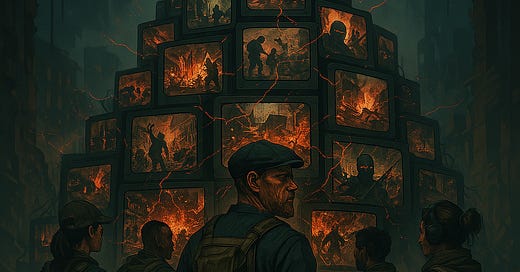Trigger Points: How Mass Shootings Became Weapons in Irregular Warfare
From tragedy to tactic—how adversaries exploit American mass shootings to fracture society, manipulate policy, and wage narrative warfare on U.S. soil.
🎯 Introduction: The Aftermath as the Arena
Mass shootings in the United States are no longer isolated tragedies—they are narrative flashpoints. While the shooters may act alone, the information ecosystem that follows is anything but. In the wake of each event, a battle unfolds—not just over facts, but over meaning, blame, and policy. This article explores how these events are exploited by foreign adversaries and ideological disruptors as part of a broader campaign of irregular warfare and Active Measures.
🧩 Key Definitions
Irregular Warfare: Conflict below the threshold of conventional war, using non-military tools like propaganda, cyber operations, and psychological manipulation to destabilize a society.
Active Measures: Soviet-era term for covert influence operations, including disinformation, forgeries, and media manipulation to shape public perception and policy in target nations.
Disruptors: Domestic or foreign-aligned actors who exploit crises to sow division, erode trust, or push ideological agendas.
Bad Actors: State or non-state entities (e.g., troll farms, extremist networks, foreign intelligence) that weaponize narratives to achieve strategic goals.
📆 Timeline of Mass Shootings & Narrative Exploitation
🧠 How the Narrative Gets Hijacked
Shock Event: A mass shooting occurs—real, tragic, and emotionally charged.
Information Vacuum: In the first 24–48 hours, facts are scarce. This is when bad actors flood the zone.
Narrative Injection: Troll farms, botnets, and ideological influencers push conflicting stories—false flags, racial motives, government failures.
Amplification: Algorithms reward engagement, not truth. Polarizing content spreads faster than verified reporting.
Policy Paralysis: With no shared reality, meaningful reform stalls. The public is divided, angry, and exhausted.
🛰️ Strategic Objectives of Adversaries
Erode Institutional Trust: Undermine faith in law enforcement, media, and democratic processes.
Exploit Cultural Fault Lines: Race, guns, religion, and mental health become battlegrounds.
Paralyze Policy: Keep Americans fighting each other so no unified action can be taken.
Export Chaos: A destabilized U.S. is less capable of projecting power abroad.
🛡️ A Reasonable Response: Narrative Sovereignty
To counter this form of irregular warfare, the U.S. must treat narrative space as strategic terrain. Here’s how:
Media Literacy Campaigns: Equip citizens to spot manipulation and resist emotional hijacking.
Transparency in Crisis Reporting: Establish protocols for verified information during mass events.
Cross-Partisan Dialogue: Create forums for shared mourning and policy discussion outside of partisan echo chambers.
Digital Counterintelligence: Expand efforts to detect and neutralize foreign influence operations in real time.
Symbolic Resistance: Use art, storytelling, and grassroots campaigns to reclaim the narrative from chaos agents.
🧬 Conclusion: The War Is for Meaning
Mass shootings are no longer just tragedies—they are narrative battlegrounds in a broader campaign of psychological and geopolitical warfare. The bullets may stop, but the information shrapnel lingers, shaping how Americans see each other, their institutions, and their future.
To win this war, we must not only protect lives—but also protect the story of who we are, and what’s REALLY going on.





